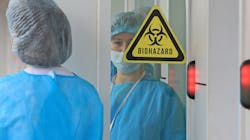Shortages of personal protective equipment (PPE)—gloves, medical masks, respirators, goggles, face shields, gowns and aprons—are leaving healthcare workers dangerously ill-equipped to care for COVID-19 patients.
The World Health Organization (WHO) has warned that mounting disruption to the global supply of PPE is putting lives at risk. They said that rising demand, panic buying, hoarding and misuse are creating a critical shortage.
“Without secure supply chains, the risk to healthcare workers around the world is real,” said WHO’s director-general, Dr. Tedros Adhanom Ghebreyesus. “Industry and governments must act quickly to boost supply, ease export restrictions and put measures in place to stop speculation and hoarding. We can’t stop COVID-19 without protecting health workers first,”
The dire warning comes as the WHO is working with governments, manufacturers and the Pandemic Supply Chain Network to boost production and secure supplies for critically affected and at-risk countries.
The public health agency is working with the World Economic Forum to engage with the private sector to support the response.
Market manipulation is widespread. Since the start of the COVID-19 outbreak, prices of surgical masks have surged six-fold, N95 respirators have trebled and gowns have doubled.
Based on WHO modelling, an estimated 89 million medical masks are required for the COVID-19 response each month. For examination gloves, that figure goes up to 76 million, while international demand for goggles stands at 1.6 million per month.
The WHO issued a statement calling on governments to develop incentives for industry to ramp up production, as well as ease restrictions on the export and distribution of PPE and other medical supplies.
COVID-19 Risk Assessment
Last week the WHO raised its assessment of the risk of spread and the risk of impact of COVID-19 to very high at the global level.
However, the agency said there is no one-size-fits-all approach to warding off COVID-19. Different countries are facing different scenarios.
WHO is advising countries on actions they can take for each of the “three Cs” scenarios—first case, first cluster and first evidence of community transmission, said WHO Director-General Tedros Adhanom Ghebreyesus.
A report of the WHO-China Joint Mission has been published. It includes 22 recommendations for China, other affected and unaffected countries, the international community and the general public.
Ghebreyesus said the report calls for all countries “to educate their populations; expand surveillance; to find, isolate and care for every case; to trace every contact; and to take an all-of-government and all-of-society approach—this is not a job for the health ministry alone.”
Workplace Preparedness and Response Plan
There are practical steps individuals can take, and workplace can update their emergency preparedness and response plans. This WHO video Q&A featuring Dr. Rosamund Lewis provides suggestions on preparing the workplace.
10 Things You can do to Prevent COVID-19
- Wash your hands regularly. Wash with soap and water, or clean with alcohol-based hand rub.
- Clean surfaces regularly with disinfectant—for example kitchen benches and work desks.
- Educate yourself about COVID-19. Make sure your information comes from reliable sources.
- Avoid traveling if you have a fever or cough, and if you become sick while on a flight, inform the crew immediately. Once you get to your destination, make contact with a health professional and tell them about where you have been.
- Cough or sneeze into your sleeve. If using a tissue, dispose of the tissue immediately into a closed trash can, and then clean your hands.
- Take extra precautions to avoid crowded areas if you are over 60 years old and/or if you have an underlying condition.
- If you feel unwell, stay at home and call your doctor or local health professional.
By the Numbers
- As of March 4, there are a total of 92,943 reported cases of COVID-19 globally, and 3,160 deaths.
- In the past 24 hours, China reported 120 cases. Most cases continue to be reported from Hubei province.
- Outside China, 2,075 cases were reported in 35 countries. Almost 90% of those cases are from just three countries.
- 119 countries have not detected any cases. And of the 75 countries with cases, 47 have 10 cases or less.
About the Author
Rehana Begg
Senior Editor, Machine Design and Hydraulics & Pneumatics

Leaders relevant to this article:
